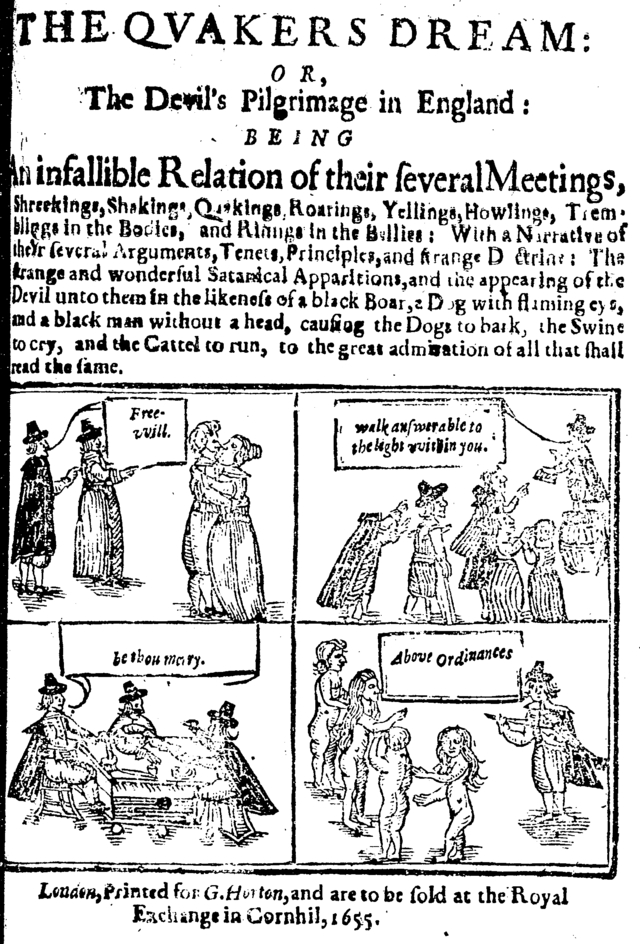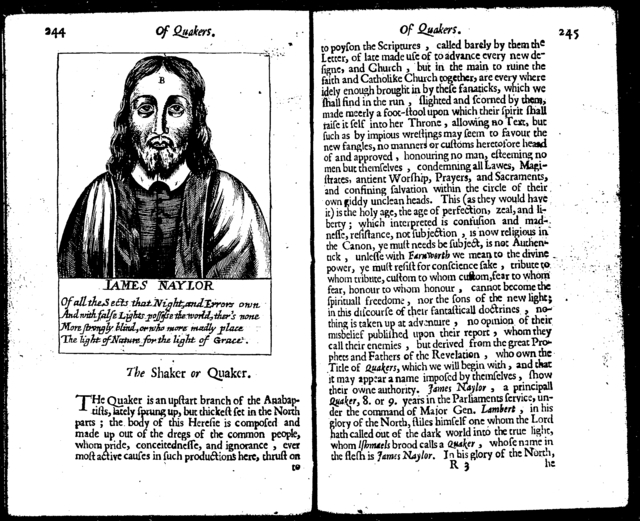The Wild, The Innocent, and The Quaker’s Struggles
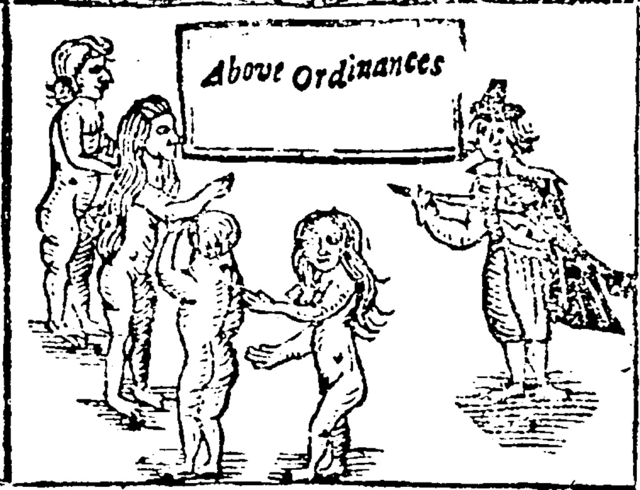
A detail of Quaker nudity from The Quakers Dream: or, the Devil’s Pilgrimage in England (1655). Wikimedia Commons
Although they were notorious for appearing naked in marketplaces, interrupting sermons, and calling for the overthrow of the church, the Quakers were extraordinarily disciplined about running riot.
It made sense for the Quakers to cultivate an exaggerated presence in order to make their voices heard among the clamor of other religious sects formed after English Civil War. But what set them apart was the volume of their printed works. During the early years of their establishment in the 1650s, Quakers published about a pamphlet a week, paid for through a collectively managed fund, and distributed by a network of itinerant preachers known as the “Valiant Sixty.” The Sixty, which were in fact more than sixty people, included George Fox, Margaret Fell Fox, Mary Fisher, and sixteen-year-old George Whitehead. Because they commanded others to tremble before the Lord, they were called Quakers, a title they re-appropriated from their critics. Among themselves, they were the Society of Friends. Unlike nearly every other group to arise out of the traumatic events of 1640s England, the Friends have survived as a religious group to this day.

The Quakers were just one among a host of new sects vying for members in seventeenth-century London. Image from A Catalogue of the Severall Sects and Opinions in England and other Nations, 1647. Wikimedia Commons
Early Quaker pamphlets were as in-your-face as early Quakers. Founder George Fox’s tracts overflowed with visions of Final Judgement, titles like The Vials of the Wrath of God Poured Fourth (1654) and The Great Mistery of the Great Whore Unfolded (1659). George Whitehead spent his teenage years in and out of jail for preaching unorthodox views with the kind of boldness that would have fit in with the Sex Pistols at the Silver Jubilee. From prison he wrote works such as Cain’s generation discover’d (1665), and The path of the just cleared: and cruelty and tyranny laid open (1655). The overarching style was passionate and apocalyptic.
But is it possible to imagine a future when you believe the world is going to end? Even though the tone of early Quaker pamphlets was mostly apocalyptic, the system of pamphlet production and distribution the Valiant Sixty built was ultimately stronger than some of the beliefs it spread. Consumers of these publications included converts across England who had been visited at one time or another by members of the Valiant Sixty. In the absence of stable leaders and places of worship, converts were taught to form weekly Meetings to keep up the faith. The pamphlets were issued at regular intervals to encourage Meetings, and to update them about experiences of the traveling Sixty. By imagining its future in print, Quakerism took on a social life of its own and became more than just a fad.
Not every reader of Quaker pamphlets was sympathetic. Ephraim Pagit added Quakers to the ranks of his catalogue of heretics, the Heresiography he had begun in 1645. Pagit saw the Quakers as the latest in a long line of upstarts.
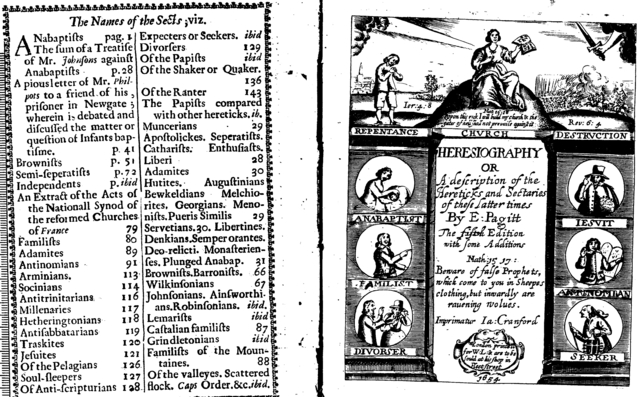
Quakers were added to the fifth Edition of Pagit’s Who’s Who of rebels, the Heresiography. Early English Books Online
Other citizens and divines whose worldviews the Valiant Sixty actively undermined produced pamphlets of their own in response to the Quakers. One critic, Thomas Underhill, described their effect on English society in a 1660 pamphlet, Hell Broke Loose:
[Quakers] are the most immodest, obscene, people in the world, next to the late Ranters. If all the Stories of their womens tripping themselves to the very skin, in the presence of men, and of mens so doing in the presence of women of late years, should be here set down, they would be enough to make a large Volume.
Underhill even provides a list of seven such streakings. Underhill’s idea of Quakers as “poisonous Weeds … with which the Garden of the Church of England is overrun,” comes largely from his perception of the “multitude of motions, in Counsels, Books, Papers, Letters, which they have sent or delivered unto every pretending Authority for these many years.” The majority of the book is comprised of quotes lifted verbatim from Quaker tracts, so widely available were they to Friends and their enemies. An earlier anti-Quaker writer, Francis Higginson, did not limit his disgust to printed matter when he complained about Quakers’ “printed Libels, and…Manuscripts that flye as thick as Moths up and down the Country.” The Quakers got as good as they gave, with detractors issuing violent outpourings of their own against them, among others Ralph Farmer’s Sathan Inthrone’d in his Chair of Pestilence, or Quakerisim in its Exaltation (1657), Thomas Smith’s A Gagg for the Quakers (1659), Lodowick Muggleton’s The neck of the QUAKERS Broken (1663), Francis Bugg’s Painted Harlot both Stript and whipt (1683).
The title-page to the Quakers Dream illustrates the major aspect of Quakerism that angered so many contemporaries: in the upper right panel the preacher preaches to “walk answerable to the light within you.” The Quaker belief in the “Inner Light” lead to a rejection of written doctrine and hierarchy, replaced with belief in equality. George Fox even wrote about the equality of men and women. Confidence in their “Inner Light” gave Quakers a certain brazen edge to their beliefs, but the “Inner Light” was also what linked Quakers to earlier religious outliers and mystics like Jakob Böhme. To the eyes of their enemies, belief in the Inner Light and rejection of the authority of Scripture (which Quakers called “letters”) posed the greatest danger of all.
The violent titles of pamphlets against Quakers were not just rhetorical. Quakers were gagged, hung, stripped, and whipped, and more than any other religious group at the time, imprisoned in horrifically overcrowded conditions. There were times when the number of Friends in prison was so high that local meetings were kept up by children.
By 1673, around two decades after the foundation of the Society of Friends, Quakers had suffered almost constantly, especially in the aftermath of the Fifth Monarchy Uprising in 1661, despite their innocence. They had officially declared themselves pacifists in an attempt to distance themselves from the violent architects of the uprising, but were faced nevertheless with legislation targeted directly at ending the movement: the Quaker Act of 1661. But they were able to print more pamphlets than ever despite persecution and the oppressive Licensing Act of 1662. Through pamphlets and traveling preachers they had gained more followers and built new communities as far away as Barbados. All of this, right under the nose of Sir Roger L’Estrange, “Surveyor” of the Press (known to contemporaries the “Bloodhound of the Press”), who particularly hated Quakers and tried constantly to shut down their printing operations.
By 1673, the structure of Meetings had expanded into something like a bureaucracy. The main event was the Yearly London Meeting. There was also the “Six Weeks Meeting,” which met to “weigh & consider of such affaires relating to Truth … as might not be judg’d fitt to be publickly discoursed.” Quaker historians such as William Braithwaite describe this as a time of settling (despite constant upheaval). Conversely, Christopher Hill regarded it as selling out the revolution, which began during the period when Quakers proclaimed themselves pacifists back in 1661.
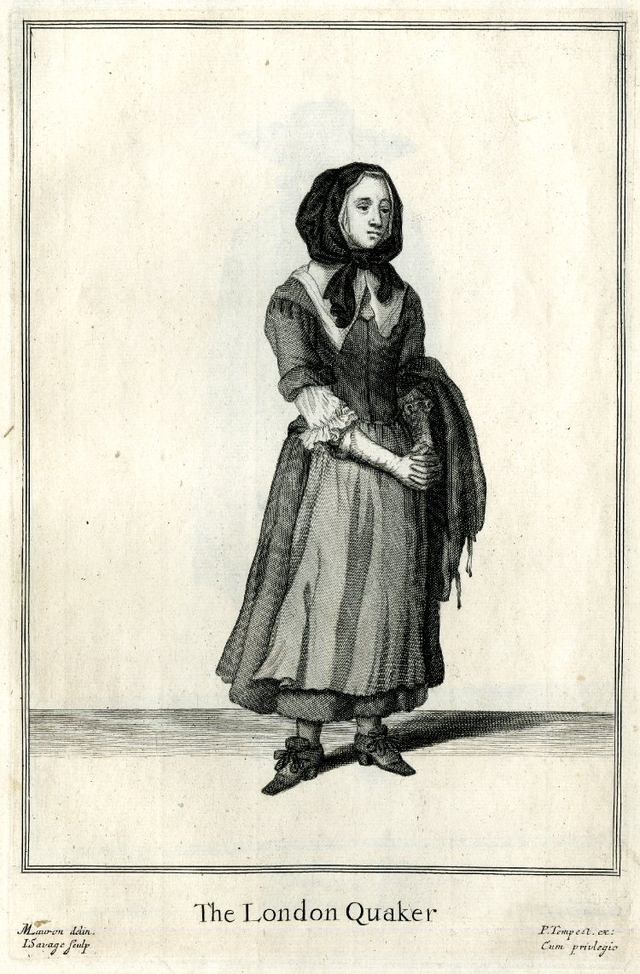
A Clothed, but loud, Quaker, from the Cryes of London, a visual guide to the soundscape of London - also including fishmongers, balladeers, and flower girls and the cries by which they hawked their wares (1688). The British Museum
Over the years, the Quaker publication process grew both more refined and more practical, helping to translate the mystical core of Quakerism into a set of tools for effective collective action. On 15 September 1673, the Quakers founded the Second Morning Meeting to undertake the task of reviewing manuscript submissions for publication, but also to maintain a library, agreeing
That 2 of a sort of all bookes written by frends be procured & kept together & for the time to come that the bookseller bring in 2 of a sort likewise of all bookes that are printed, that if any book be perverted by our Adversaryes we may know where to find it. And that there be gotten one of a sort of every book that has been written against the Truth from the beginning.
If the sheer numbers of printed pamphlets alone had first given a future to Quaker beliefs, collecting these printed pamphlets in an official library was a crucial second step, in addition to streamlining the process of submission and publication. A team of eight Friends set out to collect the books and solicit manuscripts: George Roberts, William Welch, Ellis Hookes, James Claypoole, George Whitehead, William Penn, and Ellis Hookes, who was also in charge of keeping the meeting minutes. Nicholas Jorden of Bristol, and Nicholas Cole of Plymouth, were also sent to scare up printed Quaker and Anti-Quaker tracts from their parts of the country. The Second Morning Meeting, with its origins in collective trembling, quaking, and sometimes streaking, became a unit for archiving, printing, and circulating ideas that would not be unfamiliar to activists today.
The Second Morning Meeting minutes give insight into the many different fates that could befall a book under collective decision-making. Outright acceptance and rejection of manuscripts was rarely the case. Even the most prominent Quakers submitted to the authority of the Second Morning Meeting: George Fox himself had a “paper … read and ordered to be laid by till G.F. be spoken with about it,” and a work by another Quaker leader, Isaac Pennington, had his book The soul’s food “not Judged meet to be printed.” A book written by John Bezers, read by Bezers himself aloud to the meeting, was “concluded not convenient nor safe to be printed or published.” Moreover, Bezer’s depiction of Jesus in the work caused the Meeting to persuade Bezer to “submitt & give [the book] up to the Meeting” for safekeeping—a process involving some negotiation but with which “he expressed his satisfaction therein.” Since James Naylor had been arrested and mutilated in retribution for entering the town of Bristol upon a donkey in the manner of Jesus’s entrance into Jerusalem in 1656, the Meeting upheld a ban of his writings to distance themselves from his bad reputation. They ordered “the printing of J: Naylors Bookes be suspended till it be taken into further & more generall Consideration by the 2d dayes meeting & some Antient friends of the Citty,” and did not lift the ban for nearly two decades.
This element of rejection hints at a shorthand definition suggested by some historians for the Second Morning Meeting: a censoring body. It’s also seen to be at odds with the original spirit of the Quaker movement: one of mystical visions and involuntary proclamations, or as the Quakers Dream described it, “Shreekings, Shaking, Quakings, Roaring, Yellings, Howlings.” Shaping the Quaker “message” did take up a lot of the Meeting’s agenda, but seen within the totality of the tedious corpus of meeting minutes, censorship was just one of its functions.
For instance on 30th November 1673 an “Epistle entituled a loveing seasonable advice to the Children of light” written by Thomas Taylor was deemed unfit for print, but the Meeting decided that it might be “spread & read amongst freinds in Manuscript where it may be serviceable.” Sometimes works were not printed because they were old news, for instance in John Gratton’s “answer to John Cheney … it’s so long since the Preists sheet came forth.” And since it was rumored that Cheney intended to write more (and he did, called The Shibboleth of Quakerism), they decided “the rest may be answered in one book” to conserve time and money. Aside from practical reasons, works were most often rejected to prevent “reviving troubles to friends,” either with other religious groups such as Baptists, or with authorities with the power to fine or imprison the author. In other cases, Friends writing works from prison were encouraged to withhold publication out of concern that it would “frustrate & strengthen their bonds”.
The decisions made by the Meeting were made collectively. The majority of works published underwent a process of communal review, and edits were negotiated with each author, and even rejection letters were written and signed collectively. Minutes record that final decisions as to the publication of manuscripts could be made by no less than three or four Friends. In reality more were usually present—sometimes including the author of a work, his or her family, or neighbors or friends which delivered manuscripts on their behalf. For more prominent publications, such as the collected works of a deceased Quaker, there were more readers: often manuscript collections were available on loan to interested readers. Equally, for more controversial books, there were more readers: for instance when a schism broke out in the Quaker colony of Pennsylvania, former Quaker George Keith’s books were reviewed by no less than 8 friends, “and any other that are Free.” The short form Quaker writings took, pamphlets, were key to this communal process of editing, because works were read aloud to all present, and edited orally as well. Over time, publishing longer works meant more frequent meetings, and more breakaway editorial committees. Only after edits were collectively agreed upon with the authors were manuscripts taken away by the printers, who were often present at the readings.
The Meeting format, which had its origins in collective, mystical experiences of trembling and Quaking in fear of the Lord, and which had formed part of the basis for Quaker survival through terrible persecution, also became a forum for collective skills-sharing in reading, writing, and publication. And in turn, a sense of collective education and advocacy. After all, the subject matter taken up by the Quaker press in the late seventeenth and eighteenth centuries included a number of incredibly progressive issues: pacifism, gender equality, racial equality, and prison reform.
The potential futures imagined by a few seventeenth-century hellraisers have underpinned issues of social justice that still matter today, and may have even helped give rise to them. In other words, when Hell Broke Loose, the outcome wasn’t entirely pandemonium.


